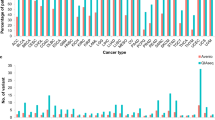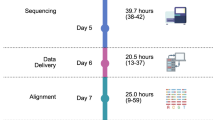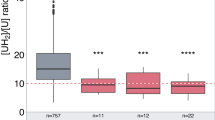Abstract
Genetic variants, including single-nucleotide polymorphisms (SNPs), are key determiners of interindividual differences in treatment efficacy and toxicity in childhood acute lymphoblastic leukemia (ALL). Although up to 13 chemotherapeutic agents are used in the treatment of this cancer, it remains a model disease for exploring the impact of genetic variation due to well-characterized cytogenetics, drug response pathways and precise monitoring of minimal residual disease. Here, we have selected clinically relevant genes and SNPs through literature screening, and on the basis of associations with key pathways, protein–protein interactions or downstream partners that have a role in drug disposition and treatment efficacy in childhood ALL. This allows exploration of pathways, where one of several genetic variants may lead to similar clinical phenotypes through related molecular mechanisms. We have designed a cost-effective, high-throughput capture assay of ∼25 000 clinically relevant SNPs, and demonstrated that multiple samples can be tagged and pooled before genome capture in targeted enrichment with a sufficient sequencing depth for genotyping. This multiplexed, targeted sequencing method allows exploration of the impact of pharmacogenetics on efficacy and toxicity in childhood ALL treatment, which will be of importance for personalized chemotherapy.
This is a preview of subscription content, access via your institution
Access options
Subscribe to this journal
Receive 12 print issues and online access
$259.00 per year
only $21.58 per issue
Buy this article
- Purchase on Springer Link
- Instant access to full article PDF
Prices may be subject to local taxes which are calculated during checkout


Similar content being viewed by others
References
Schmiegelow K, Forestier E, Hellebostad M, Heyman M, Kristinsson J, Soderhall S et al. Long-term results of NOPHO ALL-92 and ALL-2000 studies of childhood acute lymphoblastic leukemia. Leukemia 2010; 24: 345–354.
Davidsen ML, Dalhoff K, Schmiegelow K . Pharmacogenetics influence treatment efficacy in childhood acute lymphoblastic leukemia. J Pediatr Hematol Oncol 2008; 30: 831–849.
Schmiegelow K, Al-Modhwahi I, Andersen MK, Behrendtz M, Forestier E, Hasle H et al. Methotrexate/6-mercaptopurine maintenance therapy influences the risk of a second malignant neoplasm after childhood acute lymphoblastic leukemia: results from the NOPHO ALL-92 study. Blood 2009; 113: 6077–6084.
Lund B, Åsberg A, Heyman M, Kanerva J, Harila-Saari A, Hasle H et al. Risk factors for treatment related mortality in childhood acute lymphoblastic leukaemia. Pediatr Blood Cancer 2011; 56: 551–559.
Gregers J, Christensen IJ, Dalhoff K, Lausen B, Schroeder H, Rosthoej S et al. The association of reduced folate carrier 80G>A polymorphism to outcome in childhood acute lymphoblastic leukemia interacts with chromosome 21 copy number. Blood 2010; 115: 4671–4677.
Schmiegelow K, Forestier E, Kristinsson J, Soderhall S, Vettenranta K, Weinshilboum R et al. Thiopurine methyltransferase activity is related to the risk of relapse of childhood acute lymphoblastic leukemia: results from the NOPHO ALL-92 study. Leukemia 2009; 23: 557–564.
Relling MV, Yang W, Das S, Cook EH, Rosner GL, Neel M et al. Pharmacogenetic risk factors for osteonecrosis of the hip among children with leukemia. J Clin Oncol 2004; 22: 3930–3936.
Wishart DS, Knox C, Guo AC, Shrivastava S, Hassanali M, Stothard P et al. DrugBank: a comprehensive resource for in silico drug discovery and exploration. Nucleic Acids Res 2006; 34 (Database issue): D668–D672.
Hewett M, Oliver DE, Rubin DL, Easton KL, Stuart JM, Altman RB et al. PharmGKB: the Pharmacogenetics Knowledge Base. Nucleic Acids Res 2002; 30: 163–165.
Lage K, Karlberg EO, Storling ZM, Olason PI, Pedersen AG, Rigina O et al. A human phenome-interactome network of protein complexes implicated in genetic disorders. Nat Biotechnol 2007; 25: 309–316.
Hiard S, Charlier C, Coppieters W, Georges M, Baurain D . Patrocles: a database of polymorphic miRNA-mediated gene regulation in vertebrates. Nucleic Acids Res 2010; 38 (Database issue): D640–D651.
Wernersson R, Juncker AS, Nielsen HB . Probe selection for DNA microarrays using OligoWiz. Nat Protoc 2007; 2: 2677–2691.
Altschul SF, Gish W, Miller W, Myers EW, Lipman DJ . Basic local alignment search tool. J Mol Biol 1990; 215: 403–410.
Jiang H, Wong WH . SeqMap: mapping massive amount of oligonucleotides to the genome. Bioinformatics 2008; 24: 2395–2396.
Li H, Durbin R . Fast and accurate long-read alignment with Burrows-Wheeler transform. Bioinformatics 2010; 26: 589–595.
McKenna A, Hanna M, Banks E, Sivachenko A, Cibulskis K, Kernytsky A et al. The Genome Analysis Toolkit: a MapReduce framework for analyzing next-generation DNA sequencing data. Genome Res 2010; 20: 1297–1303.
Li H, Handsaker B, Wysoker A, Fennell T, Ruan J, Homer N et al. The Sequence Alignment/Map format and SAMtools. Bioinformatics 2009; 25: 2078–2079.
Quinlan AR, Hall IM . BEDTools: a flexible suite of utilities for comparing genomic features. Bioinformatics 2010; 26: 841–842.
Li Y, Vinckenbosch N, Tian G, Huerta-Sanchez E, Jiang T, Jiang H et al. Resequencing of 200 human exomes identifies an excess of low-frequency non-synonymous coding variants. Nat Genet 2010; 42: 969–972.
Durbin RM, Abecasis GR, Altshuler DL, Auton A, Brooks LD, Durbin RM et al. A map of human genome variation from population-scale sequencing. Nature 2010; 467: 1061–1073.
Buchard A, Sanchez JJ, Dalhoff K, Morling N . Multiplex PCR detection of GSTM1, GSTT1, and GSTP1 gene variants: simultaneously detecting GSTM1 and GSTT1 gene copy number and the allelic status of the GSTP1 Ile105Val genetic variant. J Mol Diagn 2007; 9: 612–617.
Campana D . Progress of minimal residual disease studies in childhood acute leukemia. Curr Hematol Malig Rep 2010; 5: 169–176.
Craig DW, Pearson JV, Szelinger S, Sekar A, Redman M, Corneveaux JJ et al. Identification of genetic variants using bar-coded multiplexed sequencing. Nat Methods 2008; 5: 887–893.
Nijman IJ, Mokry M, van BR, Toonen P, de BE, Cuppen E . Mutation discovery by targeted genomic enrichment of multiplexed barcoded samples. Nat Methods 2010; 7: 913–915.
Acknowledgements
We are grateful to the patients who participated in the study and their referring physicians. We thank Kirsten Kørup Rasmussen for very helpful technical assistance and Jannie Gregers for providing us with previously generated SNP data. We acknowledge The Technical University of Denmark Multi-Assay Core for providing technology consultation and laboratory resources. AW, MDD and LB analyzed, interpreted data and wrote the manuscript. AW performed the sequence analysis. MDD, LB, HL, KS and RG designed the experimental research project setup. LB, MDD, LRH and BFN performed the experimental work and the Affymetrix 6.0 SNP Arrays. RG performed data analysis supervision. MB and NT performed the Illumina sequencing. KA, LG, TSP and NW performed parts of the data analysis. JN provided cell lines. LG, HL, RG, SB and KS provided critical input to the project and manuscript. This study was supported by grants from The Danish Cancer Society (Grant numbers R2-A56-09-S2 and R20-A1156-10-S2), The Danish Childhood Cancer Foundation, The Otto Christensen Foundation, The Villum Kann Rasmussen Foundation, The Ministry of Health (Grant number 2006-12103-250), The Novo Nordisk Foundation, The Danish Research Council for Health and Disease (Grant numbers 271-06-0278, 271-08-0684), The University Hospital Rigshospitalet, Denmark, The Lundbeck Foundation, The research program of the UNIK: Food, Fitness and Pharma for Health and Disease, The Danish Ministry of Science, Technology and Innovation and The Wilhelm Johannsen Centre for Functional Genome Research that is established by the Danish National Research Foundation.
Author information
Authors and Affiliations
Corresponding author
Ethics declarations
Competing interests
The authors declare no conflict of interest.
Additional information
Supplementary Information accompanies the paper on the Leukemia website
Supplementary information
Rights and permissions
About this article
Cite this article
Wesolowska, A., Dalgaard, M., Borst, L. et al. Cost-effective multiplexing before capture allows screening of 25 000 clinically relevant SNPs in childhood acute lymphoblastic leukemia. Leukemia 25, 1001–1006 (2011). https://doi.org/10.1038/leu.2011.32
Received:
Accepted:
Published:
Issue Date:
DOI: https://doi.org/10.1038/leu.2011.32
Keywords
This article is cited by
-
Cerebellar mutism syndrome in children with brain tumours of the posterior fossa
BMC Cancer (2017)
-
Genomic profiling of thousands of candidate polymorphisms predicts risk of relapse in 778 Danish and German childhood acute lymphoblastic leukemia patients
Leukemia (2015)
-
Pre-capture multiplexing improves efficiency and cost-effectiveness of targeted genomic enrichment
BMC Genomics (2012)
-
Population-based rare variant detection via pooled exome or custom hybridization capture with or without individual indexing
BMC Genomics (2012)
-
Solution-based targeted genomic enrichment for precious DNA samples
BMC Biotechnology (2012)



